Last Updated on January 21, 2024 by Greg Gillson
Did you see a brightly-colored red bird, orange bird, or yellow bird in Connecticut and wonder what is was?
This page is for you!
This article shows you photos and identification of some of the most common birds in Connecticut based on color.
The list of birds found in Connecticut includes over 445 species. So, I can’t show you all of them. I’m going to assume that you saw a common bird of this color, but you certainly could have seen something less common, or even rare!
Shape (including the shape of the bill) and size are often more helpful in starting to identify a bird than the color. In fact, most birds in North American can be easily identified with a black-and-white photo!
Many birds are multi-colored, so that it may be hard to pick out a dominant color. Males and females may be colored quite differently. And some color patterns are similar among otherwise dissimilar species.
Nevertheless, I’m going to try to pick out some of the birds that you are most likely to see in backyards or towns. And I’ll show a few others that I get asked about a lot.
The birds with a noticeable amount of red on them in Connecticut covered in this article are:
- Northern Cardinal
- American Robin
- House Finch
- Ruby-throated Hummingbird
- Rose-breasted Grosbeak
- Scarlet Tanager
- Purple Finch
The birds with a noticeable amount of orange on them in Connecticut covered in this article are:
- Barn Swallow
- Baltimore Oriole
- American Redstart
- Wood Thrush
- Red-shouldered Hawk
- Veery
- Cooper’s Hawk
- Eastern Towhee
The birds with a noticeable amount of yellow on them, including lots of yellow and black birds, in Connecticut covered in this article are:
- American Goldfinch
- Northern Flicker
- Common Yellowthroat
- Yellow Warbler
- Cedar Waxwing
- Great Crested Flycatcher
- Pine Warbler
- Yellow-throated Vireo
- Blue-winged Warbler
- Palm Warbler
Red birds of Connecticut
Birds get the red, orange, and yellow in their feathers from carotenoids in the fruit, seeds, and plants they eat (source).
These carotenoid colors combine with melanin to form an infinite range of red feathers–pink, rusty, scarlet, violet, red-orange.
The following are red birds that you are most likely to see in Connecticut.
Northern Cardinal
These are one of the most common backyard birds in the eastern United States. Their bright red color and unique head profile makes them instantly identifiable to most people–whether they are bird watchers or not!
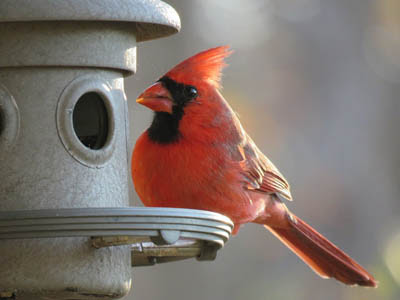 |
| Northern Cardinal. GeorgeB2 from Pixabay. |
Males of these large seed eaters are bright red with a black face and red crest.
Females replace most of the red with brown, The bill is large and orange.
These birds are found in woodlands, stream edges, residential areas.
Northern Cardinals are year-round residents throughout Connecticut.
American Robin
These are familiar lawn birds with red breasts.
 |
| American Robin. Greg Gillson. |
Male American Robins are brownish-gray above with a brick red breast. Females are paler orange below and paler gray above.
They are widespread in open country with scattered deciduous trees, residential areas.
American Robins are year-round residents throughout Connecticut.
House Finch
When people ask about a bird with a red head at their feeder, it is usually this bird.
 |
| Male House Finch. Greg Gillson. |
Males of this dusty brown striped finch have red limited to the head (specifically the forehead and eyebrow), breast (chest), and rump. The red coloration tends toward orangish, and may rarely be yellowish.
Females are streaked, similar to the males but without red. They lack any strong pattern on the face and head.
Note the small round head and curved upper ridge on the bill.
Some people call these red-headed sparrows. Sparrows and finches are similar, but in general, male finches are brighter than the females and tend to hang out more in trees. Sparrow genders are usually quite similar in coloration and tend to feed mostly on the ground.
These birds are common in residential areas, especially at bird feeders. In the West more widespread in arid regions near water.
House Finches are year-round residents throughout Connecticut.
Ruby-throated Hummingbird
These red-throated birds are the only hummingbird nesting in the eastern United States.

Males are dark green above and on the belly. They have a white upper chest. The throat is ruby-red.
Females are green above, white below, including white throat.
These birds are found in woodland edges, residential yards. Readily come to hummingbird feeders.
Ruby-throated Hummingbirds are summer residents throughout Connecticut.
Rose-breasted Grosbeak
These birds with the red breast and huge pink bill sing beautiful robin-like songs from the tops of trees.
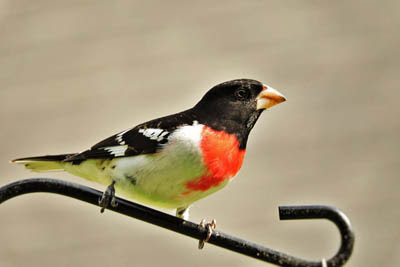 |
| Male Rose-breasted Grosbeak. Susan Killian. Pixabay. |
Males have black hood and upper parts. White under parts. Large white wing patches. Huge pink bill. Inverted bright red triangle on the breast.
Females are brown above, face with broad stripes, white throat. The under parts are buff with many thin brown streaks. Pale bill.
These birds inhabit deciduous and mixed forests. Shade trees in town. Come to feeders.
Rose-breasted Grosbeaks are summer residents throughout Connecticut.
Scarlet Tanager
A brilliant red and black bird!
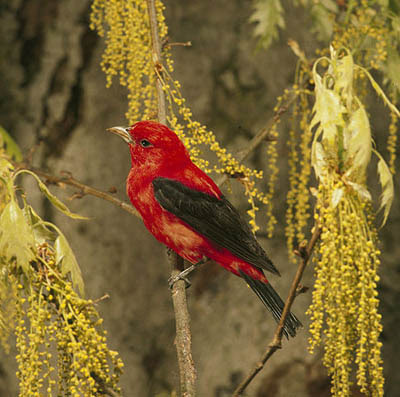 |
| Male Scarlet Tanager. USF&WS. Public Domain. |
Males are unmistakable with brilliant red with black wings and tail.
Females are olive-green above, darker wings and tail, yellower under parts. Pale bill.
These birds live in deciduous woods.
Scarlet Tanagers are summer residents throughout Connecticut.
Purple Finch
Forest finches of the foothills, delicately frosted in pinkish-red.
 |
| Male Purple Finch. Greg Gillson. |
Told from more common House Finch by bigger square or peaked head, bigger bill, lacks sharp striping below, deeply notched tail. Red covers all plumage.
Females lack red color, shows strongly patterned dark ear patch outlined all around with a pale stripe, is heavily streaked below.
Found in foothills and damp mountains conifers and mixed woods. Visit feeders, but less frequently than House Finches.
Purple Finches are year-round residents throughout Connecticut.
Orange birds of Connecticut
True orange-colored birds are not that common. Many birds that I have here are paler rusty.
The common pattern is an orange body and black or brown wings and tail. Another common pattern is for the orange to be restricted to the under parts.
The following are orange birds that you are most likely to see in Connecticut.
Barn Swallow
These orange-bellied birds are a familiar sight across North America in summer.
 |
| Barn Swallow. Greg Gillson. |
These birds are purple-blue above with orange under parts and long forked tails. The color of the underparts in winter or on females are often cinnamon or buff-colored, but breeding males can be brighter orange-red.
These birds swoop low over fields and wetlands at lower elevations. They may build their mud nests in rafters on porches, garages, or other out-buildings.
Barn Swallows are summer residents throughout Connecticut.
Baltimore Oriole
These bright orange and black birds are fairly common breeders in wooded areas in the East.
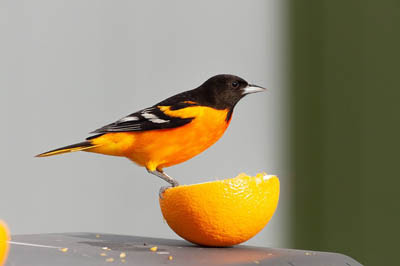 |
| Baltimore Oriole. Michael McGough. Pixabay. |
Males are have a black hood and back. Wings black with white patches. Tail black with orange sides to the base. Bright orange under parts.
Females are similar to males, but more olive above, less black. Immature birds for their first year or more are olive above orangish-yellow on the breast, fading to yellow on the belly. Two white wing bars.
These birds are common in deciduous woods, shade trees.
Baltimore Orioles are summer residents throughout Connecticut.
American Redstart
In flight these small warblers flash orange or yellow in the wing and base of the tail.
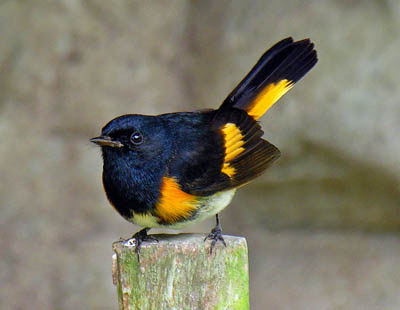 |
| American Redstart. Dennis Jarvis. Flikr. CC BY-SA 2.0 |
Males are black above, white on the belly. They have bright orange patches on side of breast, wings, and base of the tail.
Females are grayer, especially on the head. The orange of males is replaced by yellow on the females.
These birds are found in regenerating woods after a clear cut, and willow tangles along streams.
American Redstarts are summer residents throughout Connecticut.
Wood Thrush
These spotted birds with the orange-brown upper parts tend to hide in understory trees and on the forest floor.
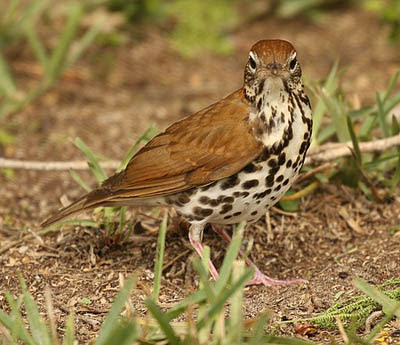 |
| Wood Thrush. Tony Castro. CC BY-SA 4.0 |
These birds are reddish brown on the upper parts, especially rusty orange on the crown and upper back. White eye ring. Large heavy black spots on the under parts.
They live in deciduous and mixed woods. Spend much time on the ground, shuffling through the leaf litter.
Wood Thrushes are summer residents throughout Connecticut.
Red-shouldered Hawk
Okay, the shoulders are reddish. But the rusty-orange breast and wing linings are barred red too.
 |
| Red-shouldered Hawk. Greg Gillson. |
The upper parts are barred black and white. The tail is banded black and white. In adults the breast is barred orange.
Immature birds are streaked with brown on the breast.
These birds like woodland edges, residential edges, riparian groves.
Red-shouldered Hawks are year-round residents throughout Connecticut.
Cooper’s Hawk
These crow-sized hawks with reddish orange bars on the under parts may show up in fall or winter to hunt birds at your feeder. Oh no!
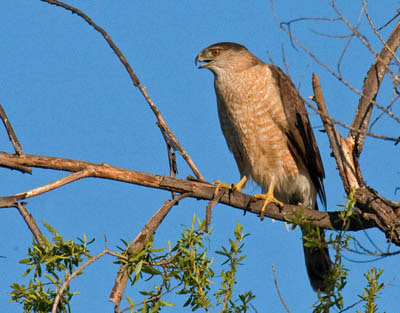 |
| Cooper’s Hawk. Greg Gillson. |
Adults with long gray and black banded tail. Dark gray above and cap on head. Under parts barred with rusty orange.
Immatures similar, brownish, streaked with brown on under parts.
Found in forests and woodlands, residential shade trees.
Cooper’s Hawks are year-round residents throughout Connecticut.
Eastern Towhee
These birds with rusty-orange sides like to hide in dense bushes.
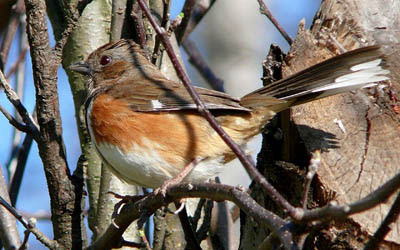 |
| Female Eastern Towhee. Skeeze. Pixabay. |
Males are black above with white wing patch, white tail corners. The sides are rusty. The belly white. Eyes variable: brown, red, orange, white, tending toward whiter southward.
Females are similar, but upper parts brown.
These birds are found in forest understory, dense brush, backyard hedges. Come to feeders.
Eastern Towhees are summer residents throughout Connecticut.
Yellow birds of Connecticut
Yellow is a common bird color! Often it is mixed with black and white plumage in birds.
Many birds with darker upper parts have yellow breast or belly.
The following are yellow birds you are most likely to see in Connecticut.
American Goldfinch
These small little birds are bright yellow and black.
 |
| American Goldfinch. Greg Gillson. |
Males are bright lemon yellow with black and white wings and tail, black cap. White under tail coverts. Pink bill.
Females are duller yellow below and brownish above. Lack black cap.
Winter birds are pale brown or gray, a touch of yellow on the throat of males.
These are birds of open country, fields with saplings, clear cuts, residential areas. They avoid dense forests, mountains, deserts. They visit feeders.
American Goldfinches are year-round residents throughout Connecticut.
Northern Flicker
These woodpeckers spend much time eating ants on the ground.
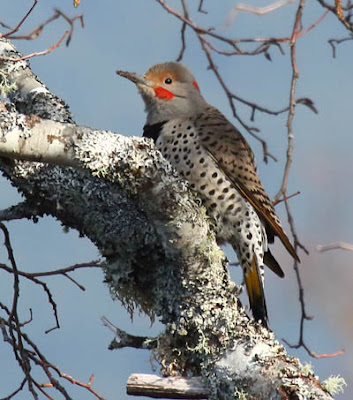 |
| Northern Flicker. Greg Gillson. |
These birds are larger than robins with brown and black barred upper parts. The underparts are pink with round black spots. There is a black crescent across the chest. When they fly away from you they reveal a large white rump.
Western birds have salmon-red under wings and under tail. Those in the East are colored yellow. The male face differs between the two populations–black whisker on the eastern birds, red whisker on western birds. Intergrades from overlap on Great Plains common. These may show male facial characteristics of both populations, or yellow-orange flight feathers.
These birds live in open woods with bare ground for foraging, residential yards.
Northern Flickers are year-round residents throughout Connecticut.
Common Yellowthroat
These buttery yellow birds are abundant in the marsh vegetation.
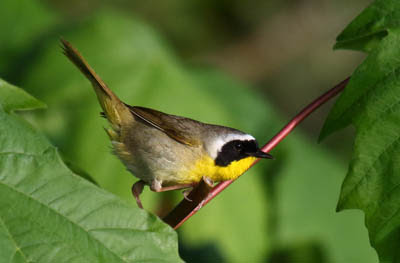 |
| Male Common Yellowthroat. Greg Gillson. |
These skulkers have bright yellow throats and yellow undertail coverts. Males have a black domino mask edged broadly in white, which females lack. Upperparts are dull olive-green.
Immature males in fall show a shadowed black mask.
Found in damp situations and heavy deciduous brambles following clear cuts.
Common Yellowthroats are summer residents throughout Connecticut.
Yellow Warbler
The golden yellow sun packed all into one little bird! Appears to be an all-yellow bird.
 |
| Yellow Warbler. Greg Gillson. |
Some populations are bright yellow, some tend toward greenish on upper parts, some more golden. Yellow internal tail corners in flight.
Males with red breast streaking, again, variable by population.
Females are somewhat to much paler yellow, some greenish, some whitish. Lack red streaks.
These birds are found in willow thickets on the edge of wetlands and ditches, stream sides in arid regions.
Yellow Warblers are summer residents throughout Connecticut.
Cedar Waxwing
These crested birds with yellow band on the end of the tail are often found in flocks. They eat flying insects in summer, fruit and berries the rest of the year.
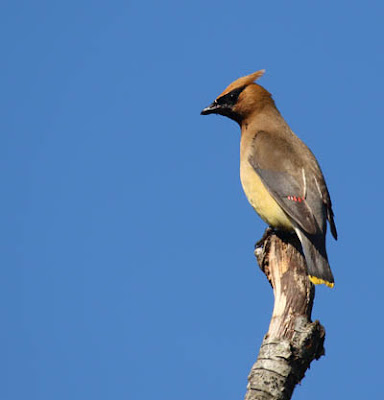 |
| Cedar Waxwing. Greg Gillson. |
These birds are fawn-brown above, with dark gray wings and tail. They have a black mask and wispy crest. The belly is yellow. The wings have waxy red drops on the end of the tertials. The end of the tail has a brilliant yellow tail band.
They are found in open habitats with berries, including juniper woodlands and towns in winter.
Cedar Waxwings are year-round residents throughout Connecticut.
Great Crested Flycatcher
These flycatchers have long tails and big heads with big bill and bright yellow belly.
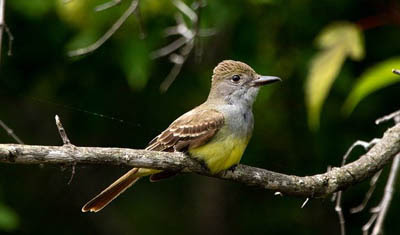 |
| Great Crested Flycatcher. Simard Francois. Pixabay. |
These birds are gray on the face and breast, brownish on rest of upper parts. Bright lemon yellow belly. The under side of the tail and some feathers of the wing are cinnamon colored.
These birds stay in the canopy of open woods.
Great Crested Flycatchers are summer residents throughout Connecticut.
Yellow-throated Vireo
Vireos are slow moving small birds that sing throughout the day. These yellow-headed vireos are one of the most colorful of their clan.
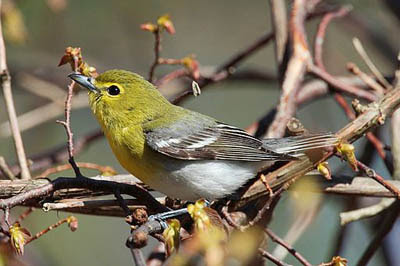 |
| Yellow-throated Vireo. MDF. CC BY-SA 3.0 |
These birds are blue-gray above, white below. Two white wing bars. Their head is olive yellow with yellow spectacles around the eye, and bright yellow throat.
These birds like large tracts of unbroken deciduous or mixed woodlands. Interestingly, however, they are often found on forest edges.
Yellow-throated Vireos are summer residents throughout Connecticut.
Pine Warbler
This yellow and gray bird is one of the few warblers to visit feeders–and the only one to eat seeds!
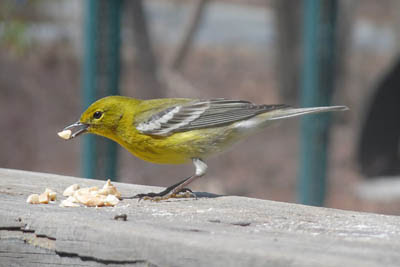 |
| Pine Warbler. Nikolaus Schultz. Pixabay. |
These birds are yellow-green on head, back, and breast. Wings blue-gray with wide white wing bars. Yellow split eye ring.
Strongly associated with pine forests. Usually high in tree tops.
Pine Warblers are summer residents throughout Connecticut.
Blue-winged Warbler
These bright birds may show up in your yard if you live at the edge of old fields or open woods. But they will not visit your feeders.
 |
| Blue-winged Warbler. Created by wirestock – freepik.com |
These small birds are bright yellow with blue wings and tail. Birds show two white wing bars. They have a thin black line through the eyes.
They are found in scrubby areas–old fields overgrown with shrubs, fence lines.
Blue-winged Warblers are summer residents throughout Connecticut.
Palm Warbler
This rather drab bird has bright yellow under tail coverts. It tends to spend much time on the ground in disturbed soils. It constantly bobs its tail up and down.
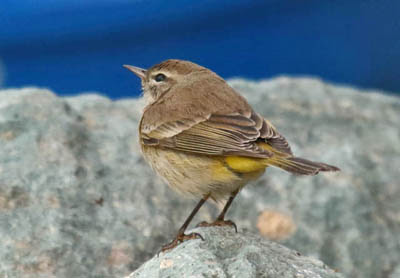 |
| Winter Palm Warbler. Greg Gillson. |
Breeding birds are rather gray with yellow throat, vent and under tail coverts. White eyebrow stripe. Chestnut cap. Eastern birds tend to be more yellowish on the breast.
In winter birds are very pale, but with yellow under tail.
They nest in bogs within boreal forests. They like similar habitat at other times of year: open land with isolated scrubby trees or bushes, including coastal scrub.
Palm Warblers are spring and fall migrants throughout Connecticut.
Wrapping Up
So, there some stunning red, orange and yellow birds to be found in Connecticut but there are also many black and white beauties as well. Here are some of my favorites:
Resident Beauties:
- Black-capped Chickadee: These lively acrobats with bold black caps and bibs flit through forests and woodlands, searching for insects and seeds.
- Downy Woodpecker: The smallest woodpecker in Connecticut, sporting a black and white body with white belly patches and a small red spot on the male’s nape. They drum on trees to attract insects and excavate cavities for nesting.
- Hairy Woodpecker: Similar to the Downy Woodpecker but slightly larger with a longer bill and a larger white belly patch. Found in diverse habitats, including forests, parks, and backyards.
- White-breasted Nuthatch: These acrobatic climbers scale tree trunks headfirst, sporting a striking black cap and breast contrasting with their white underparts. They feed on insects and seeds, often storing them in hidden caches.
Seasonal Visitors:
- Common Loons: These majestic diving birds grace the coast and lakes during winter with their black and white plumage and haunting calls. Look for them swimming or preening on the water’s surface.
- Black-throated Blue Warbler: These small warblers arrive in spring and summer, showcasing their black bib and throat against their white underparts and blue-gray upperparts. They flit through forests and woodlands, gleaning insects from leaves and branches.
- Black-and-White Warbler: A striking bird with a zebra-like black and white body pattern, seen in mature forests during spring and summer. They forage for insects by actively creeping along branches and bark.
Frequently Asked Questions
What does a Connecticut warbler look like?
The Connecticut Warbler is a rather elusive songbird, but don’t let that discourage you! Here’s how to recognize this fascinating creature:
Overall Appearance:
-
Medium-sized: Roughly 13-15 cm (5.1-5.9 in) long with a 22-23 cm (8.7-9.1 in) wingspan.
-
Slender build: Thin body with long legs and a long tail often held upright while walking.
-
Subtle but striking plumage:
- Upperparts: Olive-brown head and back, with darker streaking on the crown and back.
- Underparts: Bright yellow belly and undertail coverts, fading to paler yellow on the chest and throat.
- Distinctive features:
- Complete white eyering around the eyes, a key identification feature.
- Gray hood on the head, sometimes appearing brownish in females and younger birds.
- Long, pale bill.
Behavior:
- Ground-dweller: Unlike most warblers, it spends most of its time walking on the ground, foraging for insects and other invertebrates.
- Skulky and secretive: Prefers dense vegetation and avoids open areas, making it difficult to spot.
- Song: Loud, complex, and repetitive song, often described as a series of musical phrases and buzzes.
Why is it called a Veery?
The English name “Veery” for the Catharus fuscescens thrush comes from its distinctive, flute-like song. Here’s how the connection is made:
1. Imitative Origins:
The name is likely onomatopoeic, meaning it imitates the sound of the bird’s song. The repeated, clear notes in the Veery’s melody, often described as “veer, veer, veer,” resonate with the name “Veery.” This is a common way for humans to name birds based on their vocalizations, such as the cuckoo, whippoorwill, and yellowhammer.
2. Historical Evidence:
Early naturalists like Alexander Wilson and John James Audubon noted the connection between the song and the name. Wilson, in his 1831 book “American Ornithology,” described the Veery’s song as “a clear, mellow whistle, repeated three or four times, and slowly, as if the bird were practising a simple lesson.”

3. Alternative Possibilities:
While the onomatopoeic explanation is widely accepted, some speculate that the name might have originated from other sources.
- Dialectal Influences: Some suggest the name may have come from dialectal pronunciations of words like “very” or “veeraway.”
- Native American Languages: Others propose a connection to Native American languages, but such links haven’t been conclusively established.
Regardless of the precise origin, the name “Veery” has stuck and aptly captures the essence of this charming thrush’s melodic calls.
Where can I find Scarlet Tanagers in Connecticut?
Finding Scarlet Tanagers in Connecticut involves knowing their preferred habitats and seasonal presence. Here’s your guide to spotting these vibrant beauties:
Habitat:
- Deciduous Forests: Primarily oak woodlands, but also found in other deciduous forests like maple and beech. Look for mature trees with open understories.
- Forest Edges: Edges of forests bordering fields, meadows, or clearings provide nesting and foraging opportunities.
- Riparian Areas: Wooded areas along streams and rivers can attract tanagers during migration or forays for food.
Seasonal Presence:
- Summer Residents: Arrive in Connecticut around late April to early May and stay until August to September. This is your best chance to see them.
- Migrants: May be briefly spotted during spring (late April/May) and fall (late August/September) migration periods as they pass through the state.
Specific Locations:
- Chaney Preserve (Montville): Large trail system leading through oak-hickory forest, known for nesting pairs.
- Croft Preserve (Goshen): Several nesting pairs present in mixed deciduous forest.
- Baſſlin Preserve (Pomfret): Orange variant Scarlet Tanagers found here, along with the usual red ones.
- Rocky Neck State Park (East Lyme): Wooded areas near the coast can attract migrating tanagers.
- State Forests: Many state forests like Kent Falls, Mohawk State Forest, and Macedonia State Park offer suitable habitat for tanagers.
Related:
See photos and learn about the most common backyard birds in Connecticut, regardless of color.
Learn about the birds that come to your feeder in Connecticut.
Here’s a quick tutorial of how I would teach you to identify birds: 7 Steps to Identify Birds!
Birds with red heads in North America.
Yellow-and-black birds in North America.










